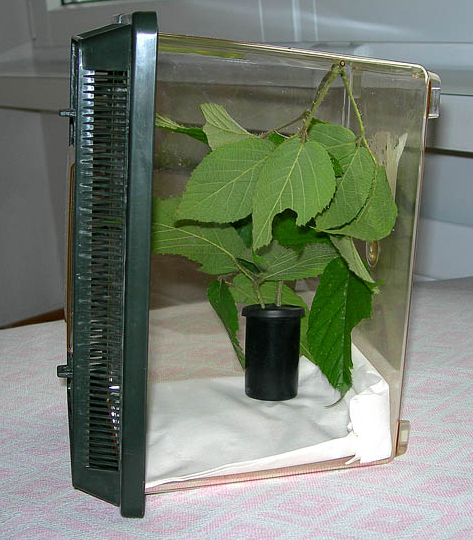This is a summary with the basic recommendations regarding cages to keep phasmids. You can find more detailed info in Facilities for Breeding.

Faunabox

- These come in different brands and different dimensions and can be easily found in pet shops.
- We use these for small and medium-sized nymphs and also adult specimens of smaller species.
- Choose the size of the Faunaboxes according to the size of the specimens housed therein.
- To offer phasmids a safer climbing and resting place (especially during moulting), glue plastic fly screen to at least one side and the ceiling of the Faunabox (with hot glue).
- Use the Faunabox in an upright position. This makes it much easier to handle the cage and the phasmids therein.
- Put a stocking over the Faunabox lid, this will prevent very small nymphs from escaping and it helps a bit to increase the humidity in the cage.
Big wooden cages

- For big nymphs and adult specimens of medium-sized or big species, it is an option to use self-made wooden cages.
- These are made from wooden crates, which one can get in different sizes from stores (e.g. Do-it-yourself stores). With some endeavour and inventiveness, one can remodel such crates to very suitable cages for phasmids. These are cheap and durable, and phasmids breed very well in such cages.
- The front of the cage is made from acrylic glass, which weighs much less and is much less fragile than glass.
- An advantage of such wooden cages is their wooden walls and ceilings. These are a much safer climbing and resting place for phasmids compared to full glass or plastic cages.
- Make sure that the wood, the creates are made of, is not treated with pesticides.
- Such wooden cages are surprisingly durable.
- The floor of such wooden cages must be protected against humidity. This can be done with plastic self-adhesive foil. Once protected like this one can even put wet paper towels on the cage floor to increase humidity.
- But cages with constantly very high humidity (e.g. for species like Heteropteryginae) should not be made of wood.
Glass / acrylic glass cages
Old aquariums can also be used as phasmid cages, especially for species which require higher humidity levels (e.g. Heteropteryginae).
Netting cages
- We use netting cages for big species and very successfully for small Phyllium nymphs. Also see how to successfully breed Phyllium.
- Such netting cages come in many different brands, the ones we are using are the best we had so far, although they are not cheap. These are called Aerarium, which are available from Bioform in Germany or Aerarium Switzerland.

